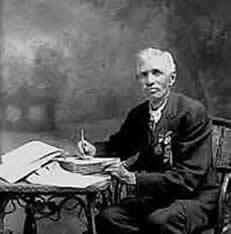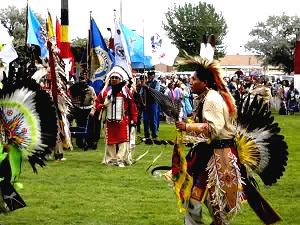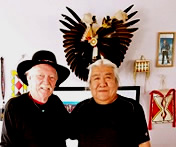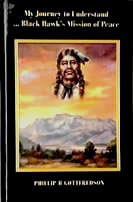Federal recognition is optional; many Native American Tribes that have deep historical and cultural roots are independent of federal recognition. Federal recognition is important to Indian tribes for several reasons. First, when they are granted federal recognition, they can establish tribal governments that possess a measure of sovereignty.
See Peter d'Errico, Legal Studies Department, University of Massachusetts/Amherst for more information on Sovereignty.
The
human remains and associated objects were accessions by the
Museum of Latter-Day Saints Church History in 1919. At that
time, a
local physician attempted to confirm a report that
the human remains
were those of the Timpanogots' Chief Black
Hawk who had died in 1870 and had been buried in the same
approximate location. The physician
collected statements from
Chana E. Hales, William E. Croft, Louise N.
Pace, and Ben H.
Bullock who had known Black Hawk. These individuals
identified many of the objects as Black Hawk's personal effects. For more information see NAGPRA's official Repatriation Document.
Origin Snake-Shoshone Timpanogos
The Snake Shoshone Nation figured prominently throughout Oregon history as far back as the 1630's, according to Oregon historian and author Gale Ontko who wrote Thunder Over The Ocoho, and lived with the Shoshone for over 70 years.
 Author Phillip B Gottfredson wrote extensively about the Timpanogos in his book "Black Hawk's Mission of Peace." The name "Timpanogostzis" is Snake-Shoshone, they are not related to any of the seven Bands of the Utes. In 1882 Hubert Bancroft wrote, "The Yutahs (eu-tahs) were comprised of several Bands of Shoshone, the most important of which are the Timpanogos who 'range through Utah Valley and the mountains adjoining the valley on the east..." Schoolcroft's Arch vol. v. p. 498. - Source: The Works of Hubert Bancroft 1882 pg 578.
Author Phillip B Gottfredson wrote extensively about the Timpanogos in his book "Black Hawk's Mission of Peace." The name "Timpanogostzis" is Snake-Shoshone, they are not related to any of the seven Bands of the Utes. In 1882 Hubert Bancroft wrote, "The Yutahs (eu-tahs) were comprised of several Bands of Shoshone, the most important of which are the Timpanogos who 'range through Utah Valley and the mountains adjoining the valley on the east..." Schoolcroft's Arch vol. v. p. 498. - Source: The Works of Hubert Bancroft 1882 pg 578.
FIRSTHAND ACCOUNTS
Spanish explorer Juan Rivera first documented the Timpanogos Nation in 1765, followed by Dominguez and Escalante in 1776. Their journals record encounters with the Eu-tahs, referred to as "the bearded ones," who spoke the Snake-Shoshone language. The group identified themselves as "Timpanogostzis" and resided near a lake they named Timpanogos. Dominguez and Escalante designated the region as "El Valle de Nuestra Señora de la Merced de Los Timpanogos" (the valley of our lady of mercy of the Timpanogos). They described the valley as lush and green, surrounded by prominent mountains. One notable peak, rising to twelve thousand feet, was named Mount Timpanogos and referred to as "La Sierra Blanca de Los Timpanogos" (the white mountain of the Timpanogos). The lake is currently known as Utah Lake. During this period, Utah Lake and the Great Salt Lake were connected by a river, as corroborated by government maps predating Mormon settlement. The Timpanogos were identified by various names, including the Lagunas, fish eaters, Yutah, Eutah, the bearded ones, the Timpangotzis, and Timpanogos.
"Turunianchi the Great" was the leader of the Timpanogostzis, and Cuitzapuninchi, Panchucunquibiran, and Picuchi were his siblings. Turunianchi had a son named Moonch (aka Old Elk, Big Elk, and Old Uintah). Moonch was the father of Chiefs Sanpitch, Yah-Keera (also known as Walker), Arapeen (father of Jake Arapeen), Tabby, Ammon, Sowiette, and Grospeen, who were collectively known as the "Royal Bloodline." Six of the seven brothers were the uncles of Nu'Iunts (Black Hawk), who was the son of Sanpitch. Dominguez and Escalante describe the Timpanogos as loving, kind, and hospitable people.
Then in 1824, explorer Etienne Provost entered what is now Utah and reported having come in contact with Mauvis Guache a Timpanogos man living along the Timpanogos River (Provo River) and Timpanogos Lake. Provo City derives it's name from this early explorer.
And explorer John C. Freemont described in his diary that in 1843 he came upon a lake (Utah Lake) and noted the river (Provo River) was named Timpanogos after the Tribe that lived there.
Excert from the history of James Bean the following: "Early in 1849 thirty to thirty five families, numbering 150 persons, were called to go south from Salt Lake into Provo Valley to settle the area. James Bean was among those called by President Brigham Young. The land to be settled was near Utah Lake, and unknown to the would-be settlers, was the traditional fishing and hunting ground for the Timpanogos Indians."
 My great-grandfather Peter Gottfredson, an emigrant from Denmark arrived in Utah territory in 1857 and lived among the Timpanogos during the Black Hawk War. Peter clearly points out in his book Indian Depredations in Utah that the Timpanogos Nation ruled the entire territory of Utah. Peter wrote: "It was with reluctance that the Timpanogos Indians who met the Higbee colony in March, 1848, permitted the first white settlement on Provo River, and that, too, in spite of the invitation previously extended to the colonists by the Chiefs, Sowiette and Walker, to settle among their Nations and teach them how to become civilized." - Peter Gottfredson/Indian Depredations in Utah
My great-grandfather Peter Gottfredson, an emigrant from Denmark arrived in Utah territory in 1857 and lived among the Timpanogos during the Black Hawk War. Peter clearly points out in his book Indian Depredations in Utah that the Timpanogos Nation ruled the entire territory of Utah. Peter wrote: "It was with reluctance that the Timpanogos Indians who met the Higbee colony in March, 1848, permitted the first white settlement on Provo River, and that, too, in spite of the invitation previously extended to the colonists by the Chiefs, Sowiette and Walker, to settle among their Nations and teach them how to become civilized." - Peter Gottfredson/Indian Depredations in Utah
I have established that the Timpanogos were living in the Great Basin of Utah long before President Lincoln created the Uintah Valley Reservation in 1861. My great-grandfather, Peter Gottfredson, lived among the Timpanogos during the mid-to-late 1800s. A friend of Black Hawk, who later became the war Chief of the Timpanogos, he was invited into his camp numerous times, and they were about the same age. Peter often spoke about the Timpanogos in his book Indian Depredations In Utah. Exhaustive research reveals they are the most documented Tribe in Utah. Still, some Mormon scholars have said they are nonexistent, which is delusional. In 1850, LDS Church leader Brigham Young ordered the "Timpanogos to be exterminated." Since then, the existence of the Timpanogos Nation has been largely ignored and omitted from history.
NOTE: Did you know there were three or more Indigenoius people living in Utah Territory who had the name 'Black Hawk?' The name "Antonga" is not a Shoshone name, or Ute name. Were in hell this name comes from is any bodys guess. I'm betting that because there were so many people with the name Black Hawk it was too confusing. Probably someone tacks on the name 'Antonga' so they know which one their talking about.
TREATIES
Treaties are an essential source of information regarding Tribal affiliation; they reveal the political nature of the conflicts and the ambitions of early colonists to bring the Native peoples into submission, and give up their land. Treaties also show the Nations and leaders who were most involved and prominent in the conflicts. For example, in a failed attempt to end the Black Hawk War, Congress authorized Treaty Negotiations for the Indians of Utah Territory. On June 8, 1865, negotiations began on the Spanish Fork Treaty exclusively with the various Bands of the Timpanogos Nation.
The significance of the Spanish Fork treaty in 1865 is that it was intended for the Snake-Shoshonee-Timpanogos Nation and signed by their leaders. None of the seven Tribes of Colorado known today as "Colorado Utes" were named. One exception was the Yampa Ute, but any right the Yampa may have had to land was lost when they signed the Ute Treaty of 1868 in Colorado. More on this bekow.
The homeland of the Timpanogos Nation was left intact. The "Sanpete Utes," referred to in the treaty, were not Ute, they were Timpanogos. Sanpete County got its name after Chief Sanpitch, Black Hawk's father, who was Snake-Shoshone Timpanogos. The Snake-Shoshone are not enrolled members of the Ute Nation and never were. It's a colonial lie that needs burying. (Source: Timpanogos Nation, Commission of Indian Affairs Annual Report 1865, O.H. Irish and Department of the Interior.)
With its nearly 1000 members, the Timpanogos Nation still, to this day, occupies their ancient homeland. This homeland was theirs long before Congress established the Uintah Valley Reservation. The reservation is but a tiny remnant of a once vast territory they call the "home of their ancestors."
The Uintah Valley Reservation Was Created In 1861
In the middle of the Black Hawk War, an Executive Order was signed by Abraham Lincoln in 1861 that created the Uintah Valley Reservation.
Caleb B. Smith, Secretary of the Department of Interior, recommended to President Lincoln that the Uintah Valley, in the Territory of Utah, be set apart and reserved for the use and occupancy of Indian Tribes of Utah. "I respectfully recommend that you order the entire valley of the Uintah River within Utah Territory, extending on both sides of said river to the first range of contiguous mountains on each side, to be reserved to the United States and set apart as an Indian reservation," he said. President Abraham Lincoln responded, "Executive Office Oct. 3, 1861," with the President's words, "Let the reservation be established, as recommended by the Secretary of the Interior." The Uintah Valley Reservation was then enacted into law on May 5, 1864, by the Act of Congress.
The Uintah Valley Reservation was for the exclusive use of the Indians of Utah Territory, namely the Timpanogos Nation, who are the indigenous 'Indians of Utah.' President Lincoln does not reference the "Uintah & Ouray Reservation." Nor make any reference to the "Utes" or "Ute Indians of Colorado Territory" whatsoever. The Timpanogos of the Wasatch were the first to be sent to the Uintah Valley Reservation in 1873. The Utes were not in Utah until 1881.
The Ute Tribe of the Uintah & Ouray Reservation 1937

Ute Powwow (Photo by Phillip Gottfredson with Tribal permission
The Ute Nation comprise seven distinctly separate Bands, all of whom have their roots in Colorado. The Mouche, Capote, Weeminuche, Tabaquache, Grandriver, Uintah, and Yampa are the Bands that comprise the Confederated Utes. Colorado Ute Chiefs were Ouray, who died August 24, 1880, Colorow died 1888, and Ignacio died December 9, 1913. There is no record of these Chiefs being in Utah or taking part in the Utah Black Hawk War.
At the close of the Utah Black Hawk War in 1873, U.S. agents forced the Snake-Shoshone Timpanogos to leave the Wasatch Front and were sent to the Uintah Valley Reservation.
The Uintah Valley Reservation had three Indian agencies, the Thornburg agency, the Uinta agency, and the Ouray agency.
These are the facts: All seven Bands that make up the Colorado Ute Nation were combined under the Confederated Ute Treaty of 1868 in Colorado and thereafter they became known as the Confederated Utes. Upon signing the treaty, the Utes relinquished all title to any land across the United States except in Colorado Territory.
In 1879, after the Meeker Massacre, the United States Government declared that the Ute people must be removed and subsequently enacted the Ute Removal Act of 1881.
After the Meeker Massacre in 1879—a tragic event in which the Utes killed an unprincipled government Indian Agent, Nathan Meeker—Congress took decisive action. In 1881, they relocated the Utes from the Ute Reservation in Colorado to the Uintah Valley Reservation in Utah Territory as 'prisoners of war.' This legislation forced three of the seven bands of the Confederated Utes—the Yampa, the Uintahs, and the Grand Rivers—from Colorado Territory to the Thornburgh Agency on the Uintah Valley. The Ute Tribe did not receive federal recognition until 1937 under the constitutional name 'The Ute Tribe of the Uintah Ouray Reservation.' Notably, Congress has never created a reservation called the Uintah & Ouray in Utah Territory, a point we will discuss in detail below.
The fourth Colorado Band to be forced to leave Colorado, known as the Tabaquache (also referred to as the Uncompahgre), was assigned to a second agency on the Uintah and Ouray Reservation, specifically the Ouray Agency. The Thornburgh Agency was dissolved. That moved the three Bands of the Thornburgh Agency to the Uintah Agency. There were just two remaining agencies, called the Uintah and the Ouray. The Government saw no need for two Agencies on the same reservation, and they then combined the Uintah and Ouray, known as the Uintah Ouray Agency, in 1885. Now all four Bands are under the jurisdiction of the Uintah Ouray Agency as prisoners of war. These four Bands of Colorado Confederated Utes are known today as the "Ute Tribe of the Uintah & Ouray Reservation."
Three remaining Colorado Bands of the Confederated Utes namely the Capote, Weeminuche, and Moache remained in south-western Colorado, just south of Durango, known today as the Southern Utes and Ute Mountain Utes, and are federally recognized.

Phillip with Kenny Frost - Ute Mountain Ute
(Southern Utes)
The Ute Tribe of the Uintah and Ouray Agency received federal recognition in 1937 under the constitutional name "Ute Tribe of the Uintah and Ouray Reservation." Although this is the official constitutional designation, no congressional action has established a reservation formally named the "Uintah and Ouray Reservation." The Ute Tribe of the Uintah and Ouray Reservation, also known as the Northern Ute, currently resides on land commonly referred to as the Uintah and Ouray Reservation.
Tenth District Court Ruling July 2017
In 1886, President Chester Arthur, by Executive Mansion (same as Executive Order), designated a small strip of land on the Uintah Valley Agency for the "temporary" use by the Colorado Utes living at the Uintah and Ouray Agency to graze their cattle. President Arthur's Executive Mansion order did not create a reservation or abrogate or diminish the Uintah Valley Reservation. Moreover, in a recent 10th District Court ruling in July 2017, the court ruled that the Uintah Valley Reservation established by Abraham Lincoln "has never been abrogated or diminished and remains intact."
CONCLUSION:
The evidence is undisputed by the courts, and though the truth is inconvenient for some Native Peoples of Utah, historians, writers, and institutions misled by Mormon history have confused the public into believing that the Timpanogos are Ute. The Colorado Ute Nation and the Timpanogos Nation are distinctly different in terms of origin, ancestral bloodlines, language, and customs. It's important to remember that the Shoshone-Timpanogos are the people of the Sundance, and the Utes are the people of the Bear Dance. The Timpanogos Nation of the Uintah Valley Reservation has never claimed to be Ute and is not an enrolled member of the Ute Tribe of the Uintah & Ouray Reservation, nor has it ever been. Understanding and respecting these unique cultures and identities is crucial in our pursuit of historical accuracy.
Each band of the Confederated Utes has its unique dialects. The Northern Utes prefer to call themselves 'Nuche' as the word "Ute" is not in their language. And "Timpanogostzis" is not in their language either. "Antonga and Black Hawk" are not in their language. And the fact is, the Colorado Utes don't recognize any of the seven prominent leaders of the Timpanogos Nation, i.e., Chiefs Sanpitch, Yah-Keera (Wakara), Arapeen (father of Jake Arapeen), Tabby, Ammon, Sowiette, and Grospeen. Only recently have some members of the Ute Tribe unofficially laid claim to certain Timpanogos leaders, but they have failed to offer any definitive proof.
(Source: Timpanogos Nation, Ute Tribe, Ute Mountain Utes, Commission of Indian Affairs Annual Report 1865, O.H. Irish, Powell, Department of the Interior, and the Bureau of Indian Affairs)
Phillip B Gottfredson began his research in 1998. Starting in 2004, he spent about four years working on a documentary film about the Black Hawk War in Utah for the Utah Division of Indian Affairs at the request of Forrest Cuch. "During those years, I asked several members of the Ute Tribe, who in the Tribe are direct descendants of Chiefs Wakara, Tabby, Arapeen, and others? They told me they didn't recognize them as their chiefs. They were renegades." they told me.
Because of so many discrepancies, I elected to drop the documentary film. However, I continued my research when, in 2015, Mary Murdock Meyer, Chief Executive of the Timpanogos Nation, contacted me in 2015. Mary provided me with a substantial number of documents, thousands of pages, proving their direct lineage to the "Royal Bloodline." See Source Material
The only time we see a Ute leader fighting in the Black Hawk War was "Chief Mountain" at the Little Diamond Battle in 1866; Timpanogos Chief Black Hawk sought assistance from numerous neighboring tribes, among them were the Utes in Colorado, to help him push back against Mormon encroachment on Indigenous lands. While Black Hawk led them in this effort, this does not mean he was Ute. It is documented Chief Mountain was a member of the Colorado Utes. Though Black Hawk considered him as his 'brother,' as it is customary for Native people to do with people they are close with, historians have misinterpreted Mountain as being a blood relative of Black Hawk. Mountain was not a blood relative of Antonga Black Hawk, they were close allies and friends.
**It's interesting to note that in the Mormon and other cultures, people refer to each other as 'brothers and sisters' but are not refering to any blood connection. Because I have close ties with Indigenous people, I am often refered to as, "brother."
Ute Tribe of the Uintah & Ouray Reservation recognize Chiefs Ouray, Colorow, and Ignacio as the principal Chiefs of the Colorado Utes and the Ute Mountain Utes. However, there is no evidence that their Chiefs were in Utah Territory or fought in the Black Hawk War, or were blood relatives of the Timpanogos.
Origin of the Ute Name
Timpanogos and Ute Tribes should To help each other and honor the friendship their ancestors shared before the Mormon's came.
"In the old days when the Utes were forced to come here, our elders told us to be kind to the Utes, they been run off their land and have no home. We need to be kind to them. And we were. And the elders of the Utes told their people, we are on Timpanogos land, this land is theirs and we need to respect that and not make trouble. Then the Mormons got involved and lied to the Utes about us, and they lied to us about the Utes. They made us so we didn't trust each other and we began to fight each other. They didn't care about us, all they wanted us to do was fight each other, tear us apart, take our land, oil and water, and our timber." - Timpanogos Nation
The Fremont Indians; Fact or Fiction? The so-called "Fremont Indians" refers to a Native American culture that existed in what is now the western United States, primarily in present-day Utah and surrounding areas. "Fremont" comes from the Fremont River, named after John Charles Fremont, an explorer who surveyed the region in the 1840s. John C. Frémont, also known as "The Pathfinder," was an actual historical figure and an explorer of the American West in the 19th century. He was born on January 21, 1813, in Savannah, Georgia, and died in New York City on July 13, 1890.
The Fremont River originates in the Fish Lake Plateau. It flows southeastward through the Capitol Reef National Park before eventually joining the Muddy River. The so-called Fremont Indians lived in the region from approximately 400 to 1300 CE.
Beginning in the 1920s, archaeologists started the study of artifacts found along the Fremont River. They couldn't attribute to any known Tribe then, so they named them "Fremont." So they're given a French name by non-Native people? This a classic example of how disinformation over time becomes fact. We can only imagine the confusion this fictitious name will cause later on down the road for researchers, readers, and historians alike.
Like the Fremont, the name "Ute" was born of confusion, and it follows it becomes a significant task to determine the actual Tribal affiliation of the Native peoples of Utah. Before the 1900s, the term "Ute" historically is used by Europeans as a blanket term when referring to any Native peoples of the Great Basin, ignoring their actual individual tribal affiliation.
The term Ute began as a metonymy (way of speaking) for the Whites and later became mainstream when referring to Native peoples in the Great Basin. Many in the Ute Tribe I have had the honor to speak with, including a Ute linguist, the late Venita Taveapont, whom I have deep respect for, and spent considerable time discussing Ute language.
Vanita explained that the word Ute is not in the Ute language. Venita said they prefer to call themselves 'Nuche' (pronounced noo-chay). There is nothing definitive that would say the name 'Ute' belonged to one particular tribe before 1868. The word "Ute" is an Anglo term. European migrants and trappers coined the term "Ute." An acronym or slang of Shoshonee words at the time, i.e., yutahs, u-tah-ats, as is the name "Utah," which is a acronym of the Shoshonee word yutahs. Yutahs, pronounced "e-u-tahs," refers to the reeds that grew around Utah Lake. The Timpanogos used the reeds to make arrows Etc.. The Timpanogos were sometimes called the Yutahs.
It is not my intention to be disrespectful to the Ute Nation in any way. I have been in many sweats with the Ute people, and I will always honor the sacred trust between us.
There is much confusion surrounding the name Ute, which is no fault of theirs. Their true history was kept from their ancestors when the government forced their children to attend boarding house schools, and were severely punished for speaking their language, and forbade them to live their sacred lifeways. I suggest that writers and historians use the name "Colorado Utes" or specify Bands of the "Confederated Utes" the Mouche, Capote, Weeminuche, Tabaquache, Grandriver, Uintah, and Yampa, and not blanket label every Native American who set foot in the Great Basin as Ute. For example, the Bands of the Shoshone indigenous to Utah, i.e., the Timpanogos Nation, Paiute, and Goshute, whose origins are shoshonee in language and customs, are distinctly different from the Colorado Utes. The fact that the historic Confederated Ute Treaty of 1868 establishes the indigenous peoples of Colorado and specific Bands as 'Ute' should be reason enough for people to distinguish them as such. Doing this would alleviate a lot of confusion in Utah's history and our understanding of the Tribal affiliation of Utah's indigenous peoples.
NEXT: The Spanish Fork Diamond Creek Battle
